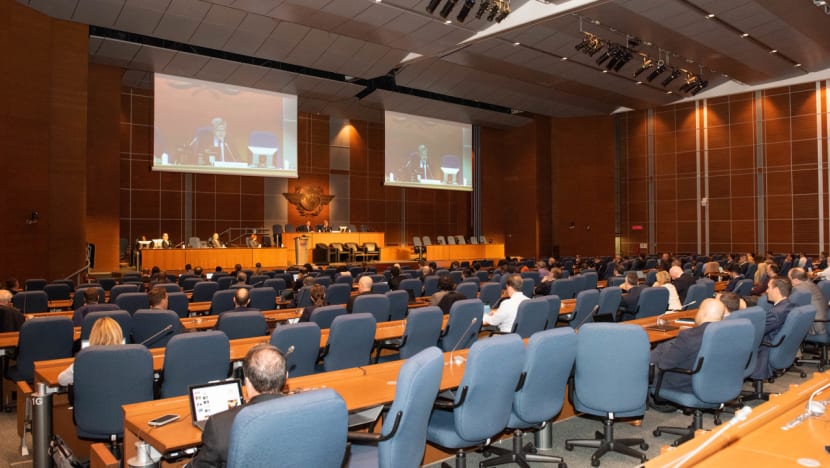CNA Explains: What’s next after the Singapore-Indonesia Flight Information Region Agreement has been ratified?

A view of a meeting held at the International Civil Aviation Organization in Montreal, Canada. (Photo: Facebook/International Civil Aviation Organization)
SINGAPORE: Global airspace is divided into different Flight Information Regions (FIR), and these demarcations do not necessarily follow territorial boundaries.
The Singapore FIR, which has been managed by authorities here since 1946 as mandated by the International Civil Aviation Organization (ICAO), currently covers some areas over the Riau Islands which include Batam and Bintan, as well as the Natuna Islands.
The FIR is managed by the Civil Aviation Authority of Singapore, a statutory board under the Ministry of Transport.
Indonesia has repeatedly expressed its wish to take over control of the FIR above Riau. Singapore has consistently pointed out that the FIR is not an issue of sovereignty, but of the safety and efficiency of commercial air traffic.
In January last year, leaders from both countries signed a number of agreements – including on the FIR issue – at the 2022 leaders’ retreat in Bintan.
Under the FIR Agreement, Singapore and Indonesia agreed to realign the boundary between the Jakarta FIR and the Singapore FIR. The agreement will see Indonesia delegate the provision of air navigation services for parts of its realigned FIR to Singapore for 25 years and can be extended by mutual consent.
Last week, Singapore’s Ministry of Foreign Affairs said that Indonesia’s ratification of the FIR Agreement – as well as a defence pact and an extradition treaty – was a sign of the strength and maturity of the bilateral relationship as well as a major step in resolving “longstanding bilateral matters”.
The ratification of all three agreements by the Indonesian government, MFA said, allows for Indonesia and Singapore to then seek approval from ICAO for the arrangements under the FIR Agreement so that all three pacts can come into force together on a mutually agreed date. ICAO is the United Nations’ aviation agency.
CNA looks back at Indonesia’s attempt to realign the FIR as well as the next steps.
LONG ROAD TO REALIGN SINGAPORE-JAKARTA FIR
According to the Jakarta Globe, Indonesia has repeatedly attempted to realign the FIR since the 1990s without success due to a lack of technological support and manpower.
The issue of FIR realignment has also often been conflated with that of territorial sovereignty, especially among the Indonesian defence establishment.
Former Indonesian Air Force Chief of Staff Chappy Hakim told local media in February last year that the issue involves Indonesia’s “dignity as a nation”.
According to the online news report by broadcaster Liputan 6, Mr Chappy questioned why part of the Indonesian airspace was controlled by another country.
This is even though Jakarta’s own FIR extends into Christmas Island, which is part of Australian airspace. The Ujung Pandang FIR - which is managed by Makassar Air Traffic Service Centre - also extends into Timor-Leste.
Prior to that, South China Morning Post reported that Mr Chappy – at the launch of his book on Indonesia’s FIR in the Riau islands in August 2019 – said that Singapore’s control of the airspace there meant that his country’s armed forces are not able to conduct exercises freely in their sovereign territory.
Related:
Back in 2017, Singapore’s then-Ambassador to Indonesia Anil Kumar Nayar wrote a letter to the chief editor of MetroTVnews after the news network ran a report that carried the comments of Mr Hakim and chairman of the Air Power Centre of Indonesia Dr Koesnadi Kardi on the FIR.
The ambassador said the report, titled "Pemerintah Harus Segera Kendalikan Penerbangan di Langit Kepri" (The government should immediately control flights over Kepri skies), misrepresented the facts.
Kepri is the acronym for Riau Islands, which also includes Batam and the Natuna Islands.
“Their comments, as reported, misrepresent the facts. First, the administration of the FIR is not an issue of sovereignty. It is based on operational and technical considerations to provide effective air traffic control services.
“This complex issue is under the ambit of the ICAO, and involves other countries and international users of the busy airspace covered by the FIR,” the ambassador had said.
Singapore, on the other hand, has always maintained that the FIR is not an issue of sovereignty but one of the safety and efficiency of commercial air traffic.
Following the conclusion of the Singapore-Indonesia leaders’ retreat in Bintan last year, Prime Minister Lee Hsien Loong said that the signing of the FIR Agreement between Singapore and Indonesia will ensure that air traffic control services are provided safely, while allowing Changi Airport to grow in the long term as an international air hub.
Singapore’s Transport Minister S Iswaran had also said then that the FIR Agreement is mutually beneficial and will meet the current and future needs of Changi Airport and Indonesian airports.
The minister told parliament last year that following the completion of the domestic processes in Singapore and Indonesia respectively to ratify the FIR Agreement, technical teams will then have to work through detailed coordination procedures. Both sides will consult stakeholders and submit a proposal to ICAO for approval, he added.
POTENTIAL HURDLES ON THE HORIZON
According to aviation expert Jae Woon Lee, how FIRs work is based on the Chicago Convention of 1944 – which is the backbone treaty of international aviation with 193 member states – as well as international customs.
“It is important to emphasise that (the) FIR is defined by ICAO under the Chicago Convention and its annexes, (and) not by individual states,” said Dr Lee, who is an assistant professor in the Faculty of Law at The Chinese University of Hong Kong.
The Chicago Convention establishes rules of airspace, aircraft registration and safety as well as security and sustainability in relation to air travel.
Dr Lee noted that there are nine ICAO air navigation regions, with one of them being the Asia region. The Singapore FIR and Jakarta FIR are part of the ICAO Asia region.
Dr Lee added that the agreement between two states – in this case Singapore and Indonesia – is the starting point for changing the FIR.
It is then subject to the approval of the ICAO Council based on the advice of regional air navigation meetings. The council comprises 36 member states elected by the ICAO Assembly for a three-year term. Singapore is currently a member of the ICAO Council, which is one of the governing bodies of the organisation.
Regional air navigation meetings are generally held once a year, Dr Lee said, with the last meeting held in November 2022 in Bali, Indonesia. He added that these meetings look into “various navigation-related issues”.
The most recent meeting in Bali was attended by 326 participants from 30 member states, as well as two special administrative regions of China and seven international organisations, including the International Air Transport Association.
“In practice, once the two states agree on the change (to the FIR), the rest (of the) states (don’t normally object to the suggestion) and the ICAO Council then supports the change,” said Dr Lee.
Mr Ridha Aditya Nugraha, an expert in international air and space law, said that the earliest possible time for the FIR realignment to be legally recognised through the Aeronautical Information Publication would be in the later half of 2024.
According to aviation website Skybrary, the Aeronautical Information Publication is a manual that contains details of regulations, procedures and other information that are important to the operation of an aircraft in a particular country.
“First, (the FIR Agreement) needs to go through the Asia-Pacific stage around September-October 2023, before it is to be discussed in Montreal,” said Mr Ridha, who specialises in Air and Space Law Studies in the International Business Law Program at Universitas Prasetiya Mulya, Indonesia. The headquarters of the ICAO is located in Montreal, Canada.
Dr Lee, the aviation expert at The Chinese University of Hong Kong, said that if there were to be any objections raised, there would be a delay at the regional meeting level.
Mr Ridha noted that another ICAO member state could potentially oppose the realignment of the FIR.
“But I do not see any state who (can) become a potential threat (to the FIR agreement).
“As long as Indonesia could guarantee Malaysia pertaining to its state aircraft operations between the West and East (between Peninsula Malaysia and Borneo Island), there is no reason for Malaysia to reject (the FIR realignment),” said Mr Ridha.
In analysing the case of FIR realignment between Singapore and Indonesia, experts have cited how both sides reached an earlier agreement in 1995. But Malaysia objected at that time as it felt that its own FIR would be affected. This prompted ICAO to reject the resolution proposed by Singapore and Indonesia.
Domestically in Indonesia, Mr Ridha said that there are issues that could also potentially hinder the FIR realignment. These include a law on national airspace management that is being drafted by the defence ministry.
According to Mr Ridha, the Bill will regulate the use of airspace among civilian and military aircraft.
“Let’s say we are talking about restricted areas - it is an area not open to the general civil aviation aircraft unless they obtain a certain permit to do so… The (Bill) is still being drafted at the moment,” he said.
“The challenge is to ensure the draft law - if approved and successfully enacted - shall not become a new front to counter Indonesia-Singapore FIR arrangements.”
Another possible hurdle noted by Mr Ridha is an ongoing judicial review of the FIR agreement between Singapore and Indonesia.
“There is also an ongoing judicial review towards the FIR realignment agreement at (the) Indonesian Supreme Court (and) whether such redelegated airspace is against the Indonesian Aviation Law of 2009,” said Mr Ridha.
According to local media reports, nine Indonesian pilots filed a judicial review against the FIR Agreement between Singapore and Indonesia in December last year.
"The submission of this judicial review is an input and request for the president … to carry out all laws and regulations in a straightforward manner and to be devoted, to the country and the nation," Mr Supri Abu, a former Air Force colonel who is among the nine pilots, was quoted as saying by Detiknews.
Mr Ridha, the aviation law expert, explained that there are some parties that are dissatisfied with the realignment of the Singapore and Jakarta FIRs, specifically on the matter where Indonesia would have to delegate the provision of air navigation services for parts of its realigned FIR.
“(There are some who have) shown strong support (for) the total realignment of the airspace,” he said.
Mr Ridha added: “Most likely the verdict shall be announced around mid-2023. (There) is still a long way to go at the national stage.”




















